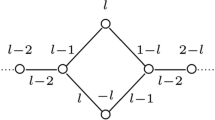Abstract
This paper is concerned with the diameter of certain word norms on S-arithmetic split Chevalley groups. Such groups are well known to be boundedly generated by root elements. We prove that word metrics given by conjugacy classes on S-arithmetic split Chevalley groups have an upper bound only depending on the number of conjugacy classes. This property, called strong boundedness, was introduced by Kędra, Libmann and Martin and proven for SLn(R), assuming R is a principal ideal domain and n ≥ 3. We also provide examples of normal generating sets for S-arithmetic split Chevalley groups proving our bounds are sharp in an appropriate sense and give a complete account of the existence of small normally generating sets of Sp4(R) and G2(R). For instance, we prove that \({\rm{S}}{{\rm{p}}_4}(\mathbb{Z}[{{1 + \sqrt { - 7} } \over 2}])\) cannot be generated by a single conjugacy class.
Similar content being viewed by others
References
E. Abe, Chevalley groups over local rings, Tohoku Mathematical Journal 21 (1969), 474–494.
E. Abe, Normal subgroups of Chevalley groups over commutative rings, in Algebraic K-Theory and Algebraic Number Theory (Honolulu, HI, 1987), Contemporary Mathematics, Vol. 83, American Mathematical Society, Providence, RI, 1989, pp. 1–17.
E. Abe and K. Suzuki, On normal subgroups of Chevalley groups over commutative rings, Tohoku Mathematical Journal 28 (1976), 185–198.
H. Bass, K-theory and stable algebra, Institut des Hautes Études Scientifiques. Publications Mathématiques 22 (1964), 5–60.
H. Bass, J. Milnor and J.-P. Serre, Solution of the congruence subgroup problem for SLn (n ≥ 3) and Sp2n (n ≥ 2), Institut des Hautes Études Scientifiques. Publications Mathématiques 33 (1967), 59–137.
C. Chevalley, Certains schémas de groupes semi-simples, in Séminaire Bourbaki, Vol. 6, Sociétémathématique de France, Paris, 1995, pp. 219–234.
D. L. Costa and G. E. Keller, Radix redux: normal subgroups of symplectic groups, Journal für die Reine und Angewandte Mathematik 427 (1992), 51–105.
D. L. Costa and G. E. Keller, On the normal subgroups of G2 (A), Transactions of the American Mathematical Society 351 (1999), 5051–5088.
R. K. Dennis and L. N. Vaserstein, On a question of M. Newman on the number of commutators, Journal of Algebra 118 (1988), 150–161.
Ś. R. Gal, J. Kędra and A. Trost, Finite index subgroups in Chevalley groups are bounded: an addendum to “On bi-invariant word metrics”, Journal of Topology and Analysis, to appear, https://arxiv.org/abs/1808.06376.
J. E. Humphreys, Linear Algebraic Groups, Graduate Texts in Mathematics, Vol. 21, Springer, New York—Heidelberg, 1975.
J. Kędra, A. Libman and B. Martin, Strong and uniform boundedness of groups, Journal of Topology and Analysis, https://doi.org/10.1142/S1793525321500497.
D. A. Marcus, Number Fields, Universitext, Springer, Cham, 2018.
A. V. Morgan, A. S. Rapinchuk and B. Sury, Bounded generation of SL2over rings of S-integers with infinitely many units, Algebra & Number Theory 12 (2018), 1949–1974.
D. W. Morris, Bounded generation of SL(n, A) (after D. Carter, G. Keller, and E. Paige), New York Journal of Mathematics 13 (2007), 383–421.
J. Neukirch, Algebraic Number Theory, Grundlehren der Mathematischen Wissenschaften, Vol. 322, Springer, Berlin, 1999.
B. Nica, On bounded elementary generation for SLnover polynomial rings, Israel Journal of Mathematics 225 (2018), 403–410.
W. Rautenberg. A Concise Introduction to Mathematical Logic, Universitext, Springer, New York, 2010.
R. Steinberg, Lectures on Chevalley Groups, University Lecture Series, Vol. 66, American Mathematical Society, Providence, RI, 2016.
O. I. Tavgen, Bounded generability of Chevalley groups over rings of S-integer algebraic numbers, Izvestiya Akademii Nauk SSSR. Seriya Matematicheskaya 54 (1990), 97–122, 221–222.
A. Trost, Quantitative aspects of normal generation of split Chevalley groups, Ph.D. thesis, University of Aberdeen, 2020.
A. trost, Bounded generation by root elements for Chevalley groups defined over rings of integers of function fields with an application in strong boundedness, https://arxiv.org/abs/2108.12254.
A. Trost, Explicit strong boundedness for higher rank symplectic groups, Journal of Algebra 604 (2022), 694–726.
P. Vámos, 2-good rings, Quarterly Journal of Mathematics 56 (2005), 417–430.
L. N. Vaserstein, On normal subgroups of Chevalley groups over commutative rings, Tohoku Mathematical Journal 38 (1986), 219–230.
N. A. Vavilov, A note on the subnormal structure of general linear groups, Mathematical Proceedings of the Cambridge Philosophical Society 107 (1990), 193–196.
N. A. Vavilov, A. V. Smolenskiĭ and B. Sury, Unitriangular factorizations of Chevalley groups, Sankt-Peterburgskoe Otdelenie. Matematicheskiĭ Institut im. V. A. Steklova. Zapiski Nauchnykh Seminarov (POMI) 388 (2011), 17–47, 309–310.
H. You, Subgroups of classical groups normalized by relative elementary groups, Journal of Pure and Applied Algebra 216 (2012), 1040–1051.
Acknowledgments
I want to thank Bastien Karlhofer for pointing out Proposition 5.5 to me and for always being willing to listen and talk about mathematics. Further, I want to thank Ehud Meir for helpful comments regarding how to write a paper, Ben Martin for being available if I had questions, and him and Jarek Kędra for tirelessly reading several iterations of this paper. I also want to thank the anonymous referee for their helpful comments and the suggestion of a strategy to potentially sharpen the statement of Theorem 5.13. This work was funded by Leverhulme Trust Research Project Grant RPG-2017-159.
Author information
Authors and Affiliations
Corresponding author
Rights and permissions
About this article
Cite this article
Trost, A.A. Strong boundedness of split Chevalley groups. Isr. J. Math. 252, 1–46 (2022). https://doi.org/10.1007/s11856-022-2344-0
Received:
Revised:
Published:
Issue Date:
DOI: https://doi.org/10.1007/s11856-022-2344-0




